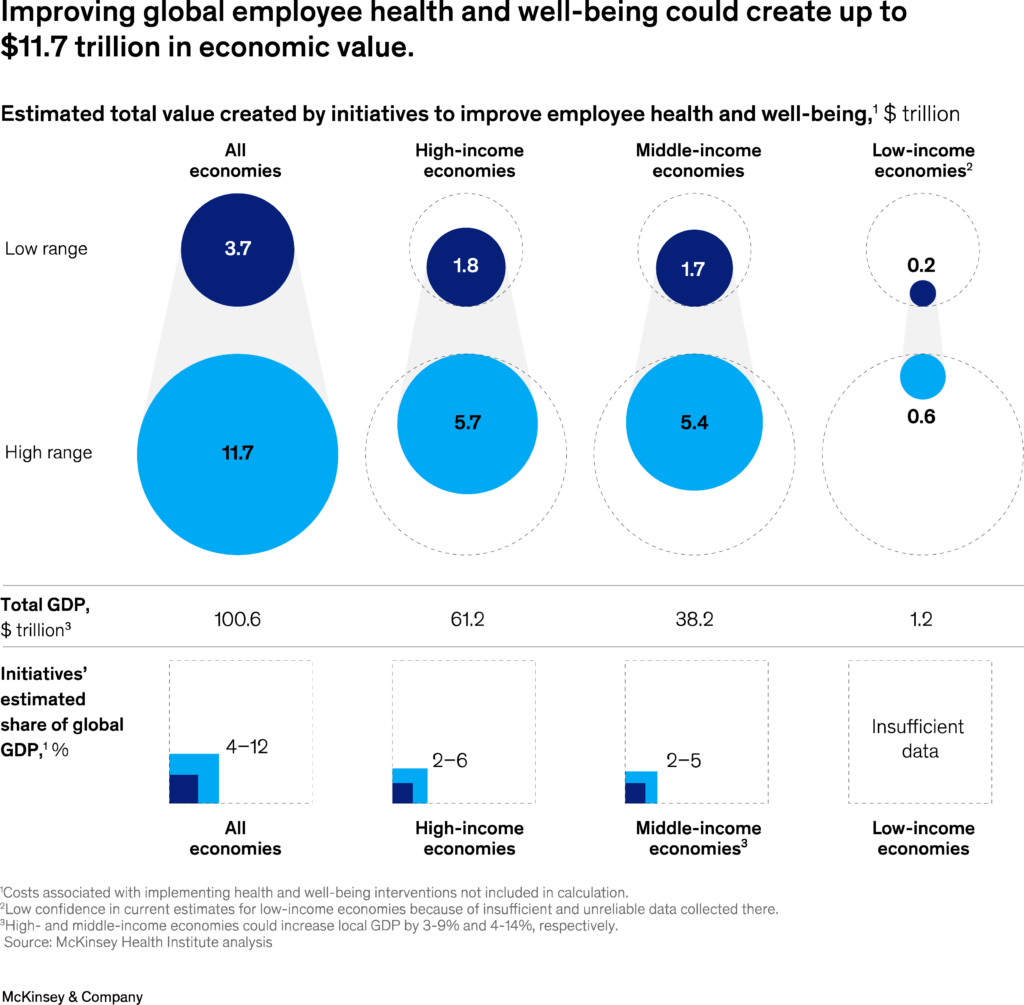by Jacqueline Brass, Lars Hartenstein, Barbara Jeffery, Patrick Simon
McKinsey Health Institute
Better aligning employment with modifiable drivers of health could unlock years of higher-quality life and create trillions of dollars of economic value.
Imagine a world in which employers make evidence-based investments in the health of their employees. In return, they reap a manifold benefit to those investments: their employees thrive, their business thrives, and the societies in which they operate thrive. There’s a positive opportunity that arises when employers address the inherent interconnectedness between work and health.
The McKinsey Health Institute (MHI) has previously identified 23 drivers of health (see sidebar “The 23 drivers of health”).1Employment can greatly influence some of these drivers, such as social interaction and sleep. In this article, we zoom in on six drivers of health that employers can influence and could be wise to support. By improving employees’ health, employers could add trillions of dollars to the global economy and have a positive impact on society. When employers and employees work together to improve modifiable drivers of health, everyone benefits.
Modifiable drivers of health in the workplace: What does the research say?
Six modifiable drivers of health in the workplace—social interaction, mindsets and beliefs, productive activity, stress, economic security, and sleep—were identified from the growing body of research that connects the dots among drivers of health and the workplace. Researchers are building a greater understanding of how employers can address modifiable drivers to create change in favor of optimal employee health.
Considering that the average person spends a third of their life at work (more than 90,000 hours in a lifetime), employment can be a critical piece of the puzzle when working toward the goal of improving global health. MHI analyzed 26 workplace factors to understand how they influence a range of health- and work-related outcomes across 30 countries. That research showed there are important differences between the workplace factors that lead to poor health and those that lead to good health. Our analysis found that employee self-efficacy, adaptability, and feelings of belonging at work were top predictors of good health, whereas toxic workplace behaviors, role ambiguity, and role conflict at work were top predictors of poor health.
Previously, researchers at the University of Oxford’s Wellbeing Research Centre analyzed data from more than 15 million employees on their well-being and the underlying workplace factors driving it.4 The researchers identified and tested 11 factors, including compensation, flexibility, purpose, inclusion, achievement, support, trust, belonging, management, and learning. The three top factors for the companies that scored best on well-being were feeling energized, belonging, and trust. Interestingly, they are different from the top drivers that employees think will make them happy and drive well-being at work: pay and flexibility.5
Together, all the research led us to identify six drivers of health that employers can most easily influence.
Employers can improve employee health through six modifiable drivers
Our analysis shows that employers can effect significant change through six modifiable drivers of health: social interaction, mindsets and beliefs, productive activity, stress, economic security, and sleep.
Social interaction
The positive effects of regular social interactions on health have been widely reported. For instance, a study reviewing mortality rates has documented an average 50 percent increase in likelihood for survival if participants have strong social relationships.1 Furthermore, social integration during childhood is related to lower blood pressure and body mass index in adulthood.2
Social interactions at work experienced by employees strongly influence health and workplace outcomes. Feeling connected at work is associated with greater innovation, engagement, and quality of work—and may be especially impactful for those with smaller social networks outside of their jobs.3 MHI’s 2023 research shows experiencing toxic workplace behavior is a strong predictor of negative health outcomes at work, including loneliness at work, the intention to leave an organization, and burnout symptoms.
Toxic workplace behavior is a critical workplace driver to combat. If left unaddressed, it can mitigate the benefits of any health and well-being initiatives pursued. Examples of interventions to counter toxic workplace behavior include establishing a zero-tolerance policy for it and creating anonymous feedback processes through which employees can report it—which also normalizes a culture of providing concrete, specific feedback to colleagues.4
Meanwhile, experiencing psychological safety on a team and support from coworkers and managers predicts positive health outcomes, including better holistic health. In 2023, MIT Sloan School of Management researchers outlined proven social-health initiatives that helped managers build psychological safety on their teams. 5 They included training managers to use one-on-one meetings to increase employee individuation6 by asking employees what was important to them and where they needed support. Another use of the meetings was to remove blockers for employees by helping them prioritize among tasks. Interestingly, individuation has been shown to increase psychological safety the most when psychological safety is relatively low, while removing blockers is more effective when psychological safety is relatively high.
Mindsets and beliefs
Research, including MHI analysis, has demonstrated a connection between positive mindsets and beliefs and better health experience.1 This includes the positive effects of a growth mindset on mental health and the benefits of gratitude on physical health. Positive mindsets and beliefs in the workplace are also greatly influential in good holistic health.
In fact, good holistic health isn’t achieved by completely avoiding workplace stressors. Instead, it can be maintained through creating positive experiences at work, such as experiencing high self-efficacy, high adaptability, a feeling of meaning, and a feeling of belonging at work. For example, an individual may be able to tolerate the stress of a looming deadline on a big project if they believe that they have the support of their team.
Employers can foster meaning and belonging by engaging employees through compelling storytelling and fostering a connection to an organization’s mission. Purpose-driven companies that excel at this grow two times faster than their competitors do and achieve gains in employee satisfaction, employee retention, and consumer trust.2 Some of these outcomes may be attributed to employees who are intrinsically motivated and able to maintain better well-being over time, creating a positive performance loop.3 Additionally, employee self-efficacy and adaptability are capabilities that can be cultivated among employees to make a more resilient and healthy workforce.4
Productive activity
Productive activity includes employment- and nonemployment-related activities. Examples include volunteering, caregiving, spending time on hobbies, worshiping, spending time on activism, playing music, and traveling.
Employment has been linked to improved life expectancy.1 According to MHI research, one of the top contributors to productivity at work is an individual’s sense of self-efficacy—an employee’s belief that they can cope with difficult or changing situations. Self-efficacy can be improved through interventions, suggesting that employers can target self-efficacy to improve employee productivity.2
Furthermore, employers have the opportunity to help the people in their communities connect to meaningful and productive activities that support their long-term health and well-being. Enjoyable leisure activities are also associated with improved psychosocial and physical measures that support good health and well-being, including greater life satisfaction and engagement and lower rates of depression, blood pressure, cortisol, and physical function.
Stress
In discussing workplace stressors, it’s important to acknowledge that stressitself isn’t necessarily a bad thing, as it’s actually needed to learn, grow, and develop.1 Optimal levels of stress can contribute to better performance. After that point, the benefits diminish into worse well-being because of the excessive demands of high stress and lack of replenishment of energy resources. The employer’s role is to ensure that employees are stimulated, challenged, and motivated—but not overwhelmed—by the demands they experience in the workplace.
Chronically elevated levels of stress can increase the risk of cardiovascular disease, neurodegenerative disease, and metabolic disease.2 Job strain and effort–reward imbalance can predict several common mental disorders.3 Additionally, MHI research shows that an increase in workplace demands is the driver most predictive of burnout and distress symptoms at work.
Some jobs are high in demand by structure. For example, some organizations have seasonal or other cyclical patterns in work demand. In these situations, interventions should focus on building in recovery time so that employees can regain their energy after high-demand periods.
Economic security
Economic opportunity and economic security can influence many facets of health and productivity. For example, high-income individuals are five times more likely than low-income individuals to report strong health.1Employees who are struggling financially are more likely than others to experience signs of poor mental health that might affect their ability to function at work.2 A lack of job stability links with poor mental health, as well as poor physical well-being (for example, cardiovascular disease).3Any short-term rise in employee performance fueled by job insecurity is often negated by the additional burden on employee physical and mental health.4
MHI research shows that the greatest contributor to employees’ feelings of financial insecurity is whether they are paid sufficiently to cover their basic needs. While what it takes to feel economically secure is unique to each person, employers can reduce feelings of financial insecurity by ensuring that compensation covers basic needs.
Sleep
There’s a strong association between sleep hours and both employee health and workplace outcomes. The cost to employers when employees have insufficient or poor-quality sleep can be substantial.
Employees with untreated insomnia cost employers an average of $2,280 more annually than employees without untreated insomnia because of absenteeism, “presenteeism,” poor performance, and increased incidents of accident and injury.1 According to the MHI 2023 survey, 31 percent of employees across the world average fewer than seven hours of sleep per night. Although everyone has unique needs, this falls below the ballpark number of hours recommended to maintain good health.2 Researchers have shown severe sleep loss can even lead to death, as our bodies conduct necessary reparative processes when we sleep.3
The MHI survey found that one of the main contributors to an employee’s average number of sleep hours is the experienced volume of work required of them. Furthermore, one of the top contributors to an employee’s satisfaction with their sleep is their ability to adjust to unexpected changes. This may suggest that employee programs that look to improve adaptability may in turn improve employees’ satisfaction with their sleep.
Employers have additional interventions they can consider if their employees are struggling with getting consistent, high-quality sleep. They include creating work environments with ample natural light and access to healthy foods, limiting or disabling employees from being online after hours, creating incentives for employees who prioritize sleep, and encouraging and rewarding leaders who model the prioritization of sleep over work.
Many employers are already investing in employee health and well-being, but we would encourage them to reflect on where they currently provide support and if they might want to change resources or add more interventions. For example, many employee assistance programs (EAPs) provide coverage of interventions for factors such as stress and economic security but less coverage of those for factors such as social interactions at work. Additionally, while EAPs are widely available, they tend to be underused by employees and focus on a reactive instead of a proactive approach to health.7
In rethinking a workplace strategy on employee health and well-being, current EAP offerings can be useful starting points for action but are unlikely to be the full solution. They are also unlikely, by themselves, to yield the ROI that employers increasingly expect. Strengthening the measurement of intervention outcomes may also help guide an organization’s overall investment strategy.
Improving global employee health can create trillions of dollars of economic value
It makes good business sense to invest in employee health and well-being. We estimate that the total global opportunity for optimizing employee health and well-being is $3.7 trillion to $11.7 trillion, which is equivalent to raising global GDP by 4 to 12 percent. Together, high- and middle-income economies represent 95 percent of this total opportunity (exhibit).

While it may not be feasible in the near term to bring all employees everywhere to optimal well-being, capturing just 10 percent of the total opportunity could yield up to $1.17 trillion of annual value and raise the global GDP by more than 1 percent (see sidebar “Business case methodology”).
In addition to contributing to increased productivity at work, our calculations indicate that investing in employee health and well-being provides a positive opportunity for attracting and retaining talent. As noted in McKinsey research, employees facing mental-health and well-being challenges are four times more likely than others to want to leave their organizations.8
Better health correlates with higher productivity across countries and workplace settings and is also strongly correlated with workforce participation at all ages.9 Every 1 to 3 percent increase in global workforce participation is worth a further $1.4 billion to $4.2 billion,10 benefiting employees, their health, the societies in which they live, and government finances.11
To capture these economic benefits fully, employers need to move from a sole focus of protecting against incidental risk and illness to helping employees achieve more optimal health. This is particularly important when considering that employees move along a continuum of health over time and may draw upon different workplace resources throughout their employment with a company. Ultimately, a focus on improving health could lead to a virtuous circle of positive change, as employees gain health literacy, and employers in turn respond to employee health concerns.
Acting now also reduces future brand and business risk. In Australia, a lawsuit resulted in a fine for an organization that tolerated a toxic workplace culture.12 Recently, the European Union adopted the European Sustainability Reporting Standards, requiring organizations by law to report on working conditions such as working time, social dialogue, and work–life balance. As employees develop higher standards for what is tolerable in the workplace, more pushback and litigation may be possible.
Furthermore, investors such as asset managers, private equity companies, and venture capitalists are increasingly weighing environmental, social, and governance (ESG) considerations in their investment decisions. They are guided by ESG ratings released by various agencies and standards issued by the International Sustainability Standards Board.
Improving employee health and well-being involves more than just employers
We have highlighted practical examples of how employers can play a role in changing norms and catalyzing innovation around employee health and well-being. However, employers alone can’t complete this task. Employees, policy makers, and local governments will need to help.
Employees can play a role in their own health by taking advantage of the workplace resources that do exist and helping cultivate a community and culture of healthy practices among colleagues. They can make their desires known to employers as a means of holding leaders accountable for responding to the health needs and aspirations of their workforces. These might include benefits such as paid parental leave and caregiving support, which aim to help employees balance work and family responsibilities while tending to their own overall health and well-being.
Policy and decision makers may want to consider a variety of ways to protect and promote employee health. Possibilities include mandating upper limits on total working hours, health coverage paid by employers, and employee access to therapy and other psychological resources.13 Enhancing standards and transparency could enable employees to make informed choices about their employment while also allowing policy makers to audit progress on a wider scale.
Through investment in public health (such as funding and grants), policy makers can encourage and enable employers to take employee health seriously and professionalize how they track the impact of their initiatives on employee health and well-being. Finally, policy and decision makers can lead by example in acting to promote their own employees’ health. This may be done in partnership with both private and other public sector employers, such as those that play a critical role in educating individuals about health—school systems, healthcare systems, and community programs—down to the city level.
City governments can play an important role in unlocking positive health outcomes. Given that most large employers are concentrated in cities, there’s a unique opportunity for companies and employees to come together to set broader aspirations on health and identify targeted interventions to pursue jointly.
Employment can and does have a profound impact on health, both positive and negative. Adapting how and where people work to support optimal employee health could result in billions of employees and their families around the world living longer, higher-quality lives—and simultaneously benefiting their employers and the societies in which they live.


